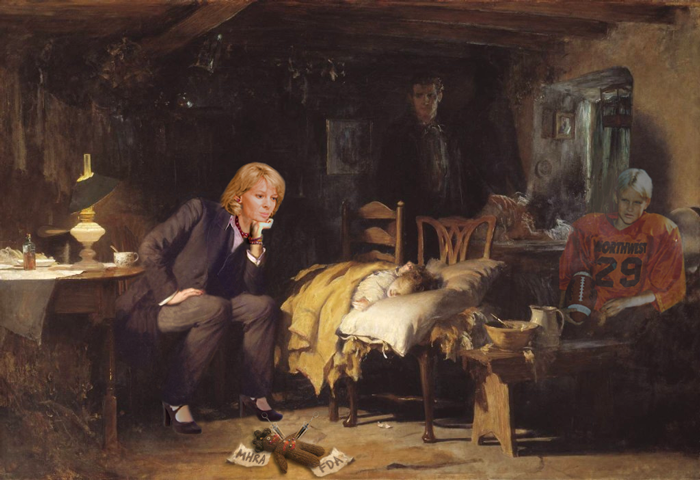
After 20 years on antidepressants, is it possible to become drug-free? Psychiatric drug withdrawal symptoms — like burning feet, akathisia and emotional hypersensitivity — are daunting, but recovery is possible as shown by this story of one woman’s path (Katie B-T) to redemption.
“After 20 years on antidepressants, I decided I wanted to taper off. It was important for me to see what life was like without them and if I could claim more of my sexuality. I had no idea what I was in store for….
“I started SSRI’s when I was 12 years old. I haven’t gotten to try out and experiment with what I like and don’t like in relationships with the new feedback my body gives me. Some of my interpersonal dynamics related to my sexuality never got worked out because I didn’t know they existed. Now I have support to explore these concerns in therapy, playing catch-up, but knowing that I won’t have to go through life missing out on this important part of myself.”
Read the full story by Katie B-T on RxISK.org: Girl on a Hot Tin Roof

Antidepressants = Sexual Side Effects
One pill makes you smaller.1
One pill makes you stall.2
And the ones your doctor gives you
Make you feel nothing at all.3
Just numbness4 and dumbness5 in bed.
Remember what your lover said,
“Lose your meds. Save our bed.
Save our bed.”
Antidepressant (SSRI) Sexual Side Effects:
- Erectile Dysfunction
- Anorgasmia
- Diminished Libido
- Genital Numbness
- Pleasureless Orgasm
Post Antidepressant (SSRI) Sexual Side Effects:
Symptoms of sexual dysfunction may persist years after quitting SSRIs, resulting in the complete loss of genital sensation.
SSRI Meds linked to Sexual Dysfunction: Lexapro, Cipralex, Cipramil, Paxil, Seroxat, Prozac, Celexa, Zoloft.
For more information of SSRI and Sexual Dysfunction see these stories by Dr. David Healy and the team at RxISK.org
Illustration: No Sex Please! (We’re on antidepressants). Based on 17th Century Kama Sutra and Ragamala paintings. © 2014 created by Billiam James.
Posted: February 17th, 2014
Categories:
Creative,
Science
Tags:
Billiam James,
Celexa,
Cipralex,
Cipramil,
Dr David Healy,
Drug Side Effects,
Lexapro,
Paxil,
Prozac,
Rxisk,
Seroxat,
Sexual Dysfunction,
SSRI,
zoloft
Comments:
No Comments.

When your doctor spends more time looking at your charts, than looking at you… You might wonder about their recommendations, especially if it’s medicated prevention strategy based on a statistical probability, like the way the health care system treats osteoporosis.
For example, if your bone-density is falls within certain guidelines, your doctor will automatically prescribe medication (in order to reduce his/her liability) for the rest of your life. Theoretically this will reduce your risk ofhaving a fracture, but the meds certainly come with a host of bad side effects, which may outweigh the benefits…
Here’s a story about one woman who decided not to surrender to her doctor’s fears.
My first bone-density scan… and now I have a label: Osteoporosis.
The primary care physician kept me waiting for 40 minutes after the time of the scheduled appointment. When she came into the office she sat down in front of a monitor and said nothing while she brought up my records. Then she spun the monitor around so I could see it. Displayed on the computer screen was my risk of osteoporotic spinal fracture – 12.4% – and hip fracture – 2.4%.
I was flustered and did not think to ask exactly how this risk is calculated and what it represents.
While I accept that I am at a higher risk of fracture than a young adult woman, I still feel my risk of fracture is not great and I don’t appreciate being made to feel fearful of my risk – or at least unduly fearful. I do not want to compromise other quality of life factors because of some very small risk of spinal or hip fractures.
She went into the risk of death from hip fractures. Yes, I am aware that a hip fracture is often the beginning of a downward spiral to death but this just doesn’t seem like the place where I am now in my life, while the risk of stomach upsets, oesophagus damage, and/or general malaise from a biphosponate seems much more immediate to say nothing of an increase in a risk of fractures in the extremities from this class of drug.
Read the full story on RxISK.org: Fragile Doctors
Illustration: Fear of Falling, © 2013 created by Billiam James
Posted: December 30th, 2013
Categories:
Creative
Tags:
Aclasta,
Actonel,
alendronate,
Billiam James,
biphosphonates,
David Healy,
Didrocal,
elective Estrogen Receptor Modulators,
etidronate,
Evista,
Fosamax,
osteopenia,
osteoporosis,
Raloxifene,
risedronate,
Rxisk,
SERMs,
zoledronic acid
Comments:
No Comments.

Drug companies maximize the sales of new drugs by hyping their benefits while downplaying significant risks. In 2010 the European Medicines Agency began releasing patient-level data from the clinical trials used to approve new medicines in Europe – a development hailed by American, and European researchers and researchers around the world as a major step towards drug safety.
This process has been shut down by a lawsuit taken by two American corporations – AbbVie, makers of Humira, the number one selling medication in the world with projected sales of $10 billion in 2013; and InterMune, whose pulmonary-fibrosis drug Esbriet has recently been approved in Europe at a cost of over $40,000 per year.
Sign the petition here: Let us see Drug Data! Drug hazards are not “trade secrets”!
Read Dr. David Healy’s post here: Letter to Stacy London
Translations:
The posters are being translated into many languages including French, Dutch, Hindi, Kannada, Spanish, Mandarin, Italian, and German as part of RxISK‘s world-wide campaign for open data on pharmaceutical research and drug safety trials.
Posted: September 20th, 2013
Categories:
Creative
Tags:
Abbott Laboratories,
AbbVie,
access to data,
Adverse Drug Reactions,
art,
Billiam James,
Crohn's disease,
Dr David Healy,
Drug Side Effects,
Esbriet,
humira,
InterMune,
medicines safety,
prescription mediciation,
psoriasis,
Rxisk
Comments:
No Comments.

And you thought high blood-sugar was dangerous… Meds for Diabetes Type 2: Reduce your blood-sugar levels and life expectancy. There have been over 83,000 Heart Attack Deaths from Avandia.
For more info see Dr. David Healy’s post: Swimming with Great Whites? If you’ve got “Diabetes” look away now.

“You And Your Meds: Are They Safe?” was held at the Art Gallery of Ontario on January 15th. It was sold-out public event sponsored by RxISK.org and the Patients’ Association of Canada, which featured presentations by Terence Young, Dr. David Healy and Dr. Sholom Glouberman on prescription drug safety. I was delighted to show six of my “pillustrated” canvases. It was great to meet everyone and share our stories…
You And Your Meds: Are They Safe?
Tuesday, January 15, 2013 from 7:00 PM to 8:30 PM
Jackman Hall at the Art Gallery of Ontario
317 Dundas St W
Toronto, ON M5T 1G4
Terence Young, Canadian MP and author of Death by Prescription
Dr. David Healy, RxISK.org founder and author of Pharmageddon
Dr. Sholom Glouberman, President of the Patients’ Association of Canada and author of My Operation
Photos by Franke James. Thank you!
Revisiting Luke Fildes painting, the Doctor, with a ghost of Matt Miller, who at 13 year was fatally medicated with Zoloft, while the voodoo from a MHRA/FDA continues to confound our doctors.
Read Dr David Healy‘s metaphorical story about the state of modern medicine:
The girl who was not heard when she cried wolf
Posted: January 16th, 2013
Categories:
Creative
Tags:
art,
Dr David Healy,
Rxisk,
thalidomide,
zoloft
Comments:
No Comments.

Samantha’s Story (Excerpts)
My story begins in January 2008, when I was running three times a week and training at kick-boxing. I had changed my diet and everything to get fit, even had my cholesterol checked. I was fit as a person could be. The only thing wrong was the smoking… So I went with my mum to the local stop-smoking clinic where we got to see the person who goes through your options.
Champix: “A Wonder Drug”
I was expecting to be offered Nicotine Replacement Patches but they kept going on about Champix and how it would work well for me. They made it out to be a wonder drug. I said I’d give it a try. I had to go to my own doctor to get the prescription for Champix (Chantix, Varenicline). I started to take the tablets the next day. I thought they were great. I didn’t want a cigarette after a few days and no side effects. By week two I had stopped smoking.
Champix: “I felt like killing myself”
When I got to week 10 of a 12 week course, all of a sudden, I felt like killing myself. This was completely out of character for me. I am scared of dying, always have been, so this was not right. I went straight to my doctor and told her and she told me to stop the Champix…
I stopped immediately. The thoughts went away after a few days. I thought I was fine and was still not smoking.
Champix: “A Small Risk of Seizure”
Then on the 25th March 2008 my partner Anthony woke up to me having a grand mal seizure in my sleep… I was told they thought I had autosomal dominant nocturnal frontal lobe epilepsy – ADNFLE to them… I was put on anti-epileptic drugs. I had side-effects from all of them and I was still having seizures. I just kept being told that it was all about finding the right drug for me.
Then a friend came round to see me and told me that he had just been to the smoking clinic to ask for Champix. He had taken it twice before and stopped smoking both times but had always started again within a month. This time they refused to give it to him as he had a history of a head injury and they said there was a small risk of him having a seizure because of that.
Champix: A Doctor’s Denial
Angrily I got the laptop out and looked to see if the Champix side-effects leaflet had been changed to mention seizures. It had not in the UK but it was in Canada. So I asked my neurologist if Champix could have triggered my epilepsy. Her words: “I am not prepared to put my job on the line by answering that question” were witnessed by my mum. That made me angrier. This is my life – how dare she say that.
My side-effects got worse. I could not eat or function. I told the neurologist I could not live like this for the rest of my life. She shouted at me, saying my choice was side-effects or life-threatening seizures. I ran out crying…
Champix: Finding the Truth
From that day, I have studied epilepsy, drugs, DNA, the brain, RNA and, most important, Champix… I have found links to ADNFLE and Parkinsons and other diseases that might be triggered in some people by Champix… It turns out that changes in cholinergic receptors – in either a4 or b2 subunits – can cause autosomal dominant nocturnal epilepsy. Varenicline is an a4 b2 nicotinic acetylcholine receptor partial agonist – it works by binding to the receptors linked to ADNFLE. The gene changes responsible are the first, and to date only, mutations described in an idiopathic epilepsy.
Read Samantha’s full story on RxISK.org: Smoke & Pfizer get in your eyes
Follow Samantha on Twitter: @varenicline
Related Research Papers:

Dr David Healy writes that “The unsolvable problem medicine faces is that each of us is shipwrecked in the singular.” We are abandoned, floating alone in a health care system that has been trussed in guidelines, and narrow-minded “quality improvement programs”, and an incredibly bureaucratic management pot.
Our only hope is that the basic humanity of people in the system will assert itself. That the doctors, nurses, and support staff will start to look at their “clients”, not as units to be processed, but as individual human beings who need to be listened to, respected and treated with personal care.
Read Dr David Healy’s complete post: The Shipwreck of the Singular
Posted: January 16th, 2013
Categories:
Creative
Tags:
art,
Dr David Healy,
healthcare,
Rxisk
Comments:
No Comments.

“Uninhibited behaviours” is listed as a possible side effect for Effexor by it’s manufacture, Pfizer. But what is uninhibited behavior? Is it problematic? Well, yes… According to Pfizer, compulsive gambling and sexual misconduct are covered by the term, “uninhibited behaviours”.
A warning… But is it enough? A patient responds:
“How am I supposed to know what an ‘uninhibited behaviour’ was?” he said. “What a cloaking of an evil thing is that? That could be me parachuting or hang gliding or running down the beach with Speedos on! How was I to know it was going to be the type of addictive behaviours that would ruin my life?”
Efexor, first introduced to the American market in 1993, is now well established as one of Australia’s most commonly prescribed anti-depressant medications with more than 1.2 million prescriptions serviced in Australia in the past 12 months. At low and moderate doses, it acts only on the brain’s mood control neurotransmitters, serotonin and norephinephrine. But at high doses of over 300mg a day it also effects a third neurotransmitter called dopamine, which is responsible for reward-driven behaviours and has been associated with risk-taking behaviour and addiction.
It’s this dopamine effect that can cause problems, according to world-renowned psychiatrist, psychopharmacologist and author Dr David Healy. “When Efexor is taken at high dosages it triggers a flood of dopamine and becomes what we call a ‘dopamine agonist’. This can be responsible for the types of dangerous impulsive behaviours.”
Read the full story on RxISK.org: Gambling With Antidepressants
Posted: January 16th, 2013
Categories:
Creative,
Science
Tags:
art,
Dr David Healy,
Efexor,
Effexor,
Pfizer,
Rxisk
Comments:
No Comments.

One of the hardest things for people, who suffer from illnesses/disabilities, is getting good information and support. The health care system doesn’t seem to provide it, and so many of us join community support groups where we can share our experiences and support each other. (I go to Epilepsy Toronto and know many who use Fluoroquinolone support groups. The FQ groups are certainly not supported by any Pharmas, but my epilepsy group gets funds from UCB, the people who sell us Keppra and Vimpat.)
The pharmaceutical industry is very aware of this, and lends their financial muscle to support all kinds of community support groups — particularly if group members are potential “customers” for their meds. And this can create a Conflict of Interest, and subvert the group’s mission to serve its members.
This appears to be what has happened to American Foundation for Suicide Prevention. My friend Julie Wood, a suicide survivor, decided to attend a local support group this month, only to find that they were promoting medications as the only way to reduce suicide risk, and trying very hard to ignore the well-documented links between suicide risk and psychiatric meds.
What I find particularly bad about this practice, is that pharmaceutical industry is preying on the weak and sick, offering them hope (a pill?) wrapped in sympathy and support, when in fact they don’t seem to care about whether the medication works or not, or whether it actually helps the patient…
Read Julie’s full story on RxISK.org (Data Based Medicine):
http://wp.rxisk.org/how-pharma-captures-bereaved-mothers/
Posted: November 28th, 2012
Categories:
Creative
Tags:
AFSP,
American Foundation for Suicide Prevention,
art,
Billiam James,
CoI,
Conflict of Interest,
Dr David Healy,
Drug Side Effects,
Rxisk,
suicide
Comments:
2 Comments.


The Myth of Floxing
We all like to believe that medicines work like a single magic dart that’s focused and targeted on the primary therapeutic effect.
But with most drugs, it’s more like you shooting yourself with hundreds of poisoned arrows. Some hit the target, but many, many others will hit and attack other parts of your body’s vital systems — some of which, as first glance, seem to be completely unrelated.
The Fluoroquinolones class of drugs may be the worst offenders that have ever been approved by the FDA. Branded with names like Levaquin, Cipro and Avelox, they provide a horrific example of how a medicine can cripple and affect every system in the body. And what’s worse, the side effects causes by Fluoroquinolones do not end when you stop taking the drug, leaving many people crippled for years, and even decades after taking just one pill. Read more about this in Dr. David Healy’s post on RxISK.org: The Myth of the Magic Bullet: Flox Tox
The idea behind the illustration: When Venus (by Bouguereau) takes Levaquin (by Ortho-McNeil), she gets transformed into St Sebastian (by Il Sodoma) and martyred with a thousand arrows.
About Fluoroquinolones: by the Quinolone Vigilance Foundation
Quinolones (fluoroquinolones) are a class of antibiotics that are currently one of the most commonly prescribed antibiotics in the world, given out in hundreds, if not thousands, of prescriptions daily. They are very powerful medications prescribed to treat a wide variety of infections but were never meant to be used as a first line of defense against routine infections, which is how they are often prescribed today. Like all antibiotics, quinolones, have the ability to cause side effects. However, what differentiates this class of antibiotics from others is that quinolones can cause severe adverse reactions that can disable the healthiest of individuals creating long lasting injuries.
For more info on Fluoroquinolones visit: Quinolone Vigilance Foundation
If your doctor is recommending a Fluoroquinole class antibiotic, read these victim survivor stories before taking even one pill: The Fluoroquinolone Wall of Pain
Posted: September 6th, 2012
Categories:
Creative,
Science
Tags:
Adverse Drug Reactions,
Antibiotics,
art,
Avelox,
Bayer,
Cipro,
Dr David Healy,
FDA,
Floxed,
Floxies with Moxy,
fluoroquinolones,
health,
Levaquin,
Maxaquin,
Noroxin,
Ortho-MacNeil,
Rxisk,
Tequin
Comments:
14 Comments.




















